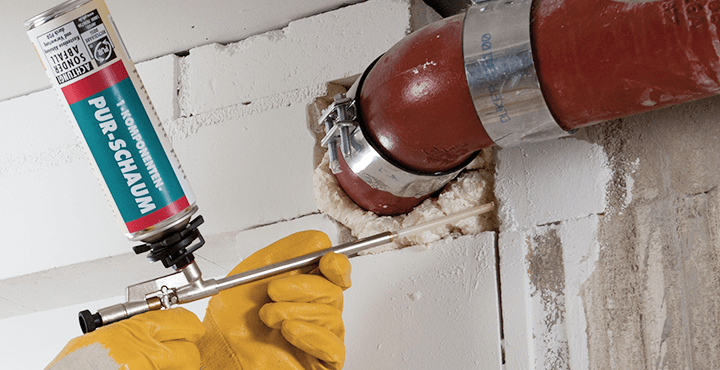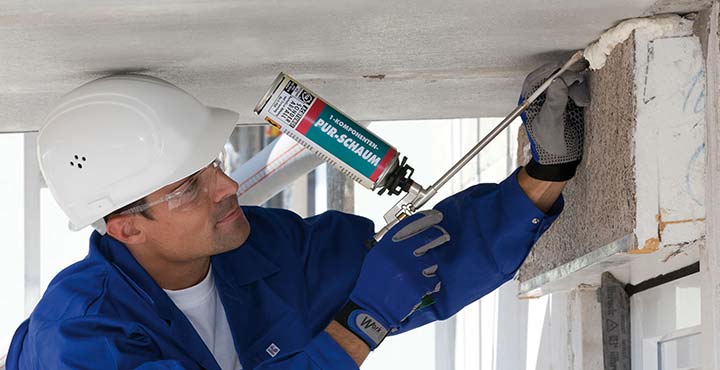
Working with PU foam
Where can I find PU foam that works at temperatures of - 25°C?
Does hardened assembly foam need to be covered to avoid contact with indoor air and prevent health risks?
Can plaster be simply applied over PU foam?
Is it possible to install a window simply using PU foam?
Is PU foam suitable for filling openings in brick walls?
How can I store an opened PU can?
Why do PU foam cans need to be used upside down?
How can construction foam be removed again?
Why do surfaces need to be moistened first?
What do I need to take into account when working with PU foam?
What do I do, if I can’t hold the PU foam can so that the valve is facing downwards, e.g. under a ceiling?
What do I need to take into account when filling hollow spaces?
How is a foam gun cleaned?
Where can I find PU foam that works at temperatures of - 25°C?
The winter foams sold in Germany can usually be used up to -10°C. PU foams that work at lower temperatures are sold in other countries that have much longer and colder winters. You should ask the manufacturers. There is a list of leading manufacturers of PU foam by PDR.
Does hardened assembly foam need to be covered to avoid contact with indoor air and prevent health risks?
No. However, for technical reasons the foam is always covered whenever PU foam is used. For instance, when PU foam is used in its main application field, i.e. ensuring that window joints are air-tight, window insulation is stipulated to prevent draughts and heat loss. Also, purely for appearance, the PU foam should always be covered. If assembly foams are exposed to light permanently, the hardened foam will turn light to dark brown. This not only does not look nice, it makes the foam brittle. Therefore the hardened foam should be protected from UV light by a coat of paint or plaster, or by applying a sealing agent.
Can plaster be simply applied over PU foam?
It is usually very easy to paint or plaster over PU foam. It is usually compatible with the common pants, lacquers and plasters.
Is it possible to install a window simply using PU foam?
PU foam is ideally suited for thermal insulation of the window joints. Its adhesive effect also helps when fitting the window and, to a certain extent, PU foam is also airtight. However further steps are necessary to ensure that the window is airtight and is fitted correctly in line with the recognised rules of engineering. For instance, mechanical attachment of the window frame is mandatory. There are a large number of technical books that address this highly complex trade. The most well-known is the RAL guide 'Window Fitting'. For more information, please click here.
Is PU foam suitable for filling openings in brick walls?
Filling openings in brick walls with PU foam is one of the most common application fields for this material in the can.
How can I store an opened PU can?
It is generally possible to re-use partially spent 1-K-PU foam cans. To do this, either the adapter tube or the spray gun need to be cleaned directly after processing using a PU foam cleaner, and all foam residues that could harden need to be removed. However, the opened construction foam can should still be used up as soon as possible. All cans, partially used or new, should be stored in an upright position. Partially used cans in particular tend to have clogged valves unless special clog-free valves are used (e.g. so-called safety valves).
2-K cans must be used in one go. They cannot be used later because the hardening component was activated and hardens the foam still inside the can.
Why do PU foam cans need to be used upside down?
In contrast to classic aerosol cans, PU foam cans do not have a so-called riser tube that pumps the fluid content outwards when the spray head is pressed. Because PU foam is viscous, a transport tube of this kind would become clogged. Therefore, the can needs to be turned upside down to empty it after the pre-polymer has been mixed with the propellant by means of shaking. This causes the viscous mass to sink downwards to the valve and ensures that there is always a sufficient amount of PU foam at the valve opening and the foam can be applied evenly without interruption.
How can construction foam be removed again?
Fresh PU foam that has not yet hardened can be simply wiped off with a cleaning cloth. Once the assembly foam is hard, removal is much more difficult. Due to its good adhesion properties, hardened construction foam is difficult to remove mechanically. Larger excesses can be simply cut off with a knife. For all other residues, use a PU foam remover that most manufacturers of assembly foams stock. The PU cleaning agent is simply applied to the hardened PU foam residues as stated in the instructions. Within about an hour, it has softened the hard construction foam allowing it to be simply wiped off with a damp cloth. Caution: the cleaning agent can corrode and dull painted or coated surfaces. Therefore, always check compatibility on an inconspicuous place before using. It is also advisable checking the technical information sheet of the product. It is generally not a good idea to allow the product to come in contact with the skin. You can only try to rub off the foam with plenty of water, detergent and patience. It is better to wear protective clothing when using PU foams, i.e. gloves and long sleeves so that no drops land on the skin.
Why do surfaces need to be moistened first?
The hardening process of 1C assembly foam can be accelerated if water is sprayed slightly onto the surface. The reason: 1-component PU foam needs moisture to harden. It hardens from outside in. If there is no moisture, because the air is to dry, this process is delayed.
What do I need to take into account when working with PU foam?
Anyone working with construction foam should wear gloves and goggles. One of the greatest advantages of PU foam is its excellent adhesion properties. The effect you want on your building is something you need to avoid on your skin! Even very fresh foam is very sticky and can only be removed from the skin mechanically or with chemicals. Therefore, appropriate protective clothing should be worn to avoid accidental contact with the eyes or skin.
What do I do, if I can’t hold the PU foam can so that the valve is facing downwards, e.g. under a ceiling?
Even cans held with the valve facing upwards can work, if a few simple details are observed.
Here are six tips:
- Use a PU foam can that is not yet opened.
- If possible, use fresh foam.
You can recognise this by shaking the can. The more fluid the content, the fresher the PU foam! - The PU foam can should be warm. This means the foam should be about 25 °C.
This makes the content more fluid and it can exit the can more easily! - Shake the can thoroughly before use, so that the content is mixed well.
This improves the quality of the exiting PU foam. - Open the valve fully.
- Use a small construction can if possible.
The smallest 1-component PU foams are supplied in 150 ml cans. The next largest can is approx. 300 ml in size. 400 and 500 ml are OK. The 750 - 850 ml foams are too large for this purpose.
Anyone who observes these tips will be able to work without problems. However, a little more residual content than usual will be left in the PU foam can.
What do I need to take into account when filling hollow spaces?
If you use a 1C foam, the surface must be dampened to ensure that the PU foam finds adequate moisture for its hardening process. Also, proceed step-by-step. First apply one layer and allow to dry (approx. 10 – 20 min.), then continue with the next step. If the layers are too thick, the drying and also the hardening process will take longer. In the case of large hollow spaces, we recommend using 2C PU foam because this does not require moisture to harden. In both cases it is important to always ensure that the work area is well ventilated to prevent the creation of an explosive air-gas mix.
How is a foam gun cleaned?
If possible, use a special gun cleaner, and start by cleaning the gun adapter. Then screw your PU gun onto the PU cleaner cartridge and let the fluid run through the gun until it is clear when it exits.
You will find more advice in our chapter‘How to clean a PU foam gun’








